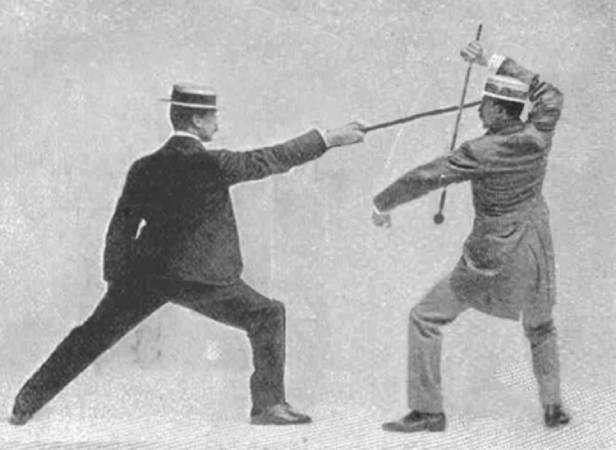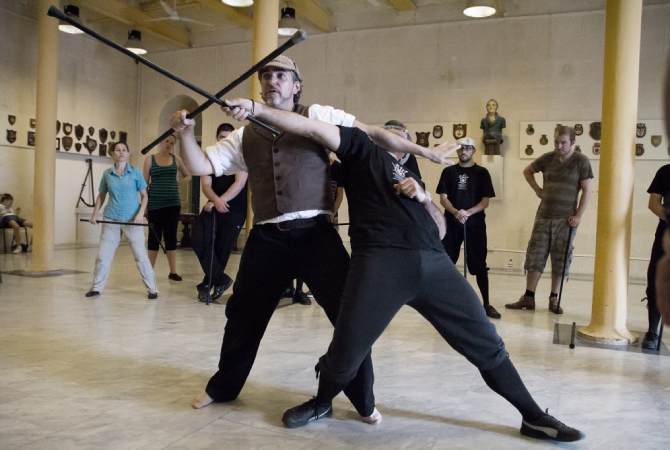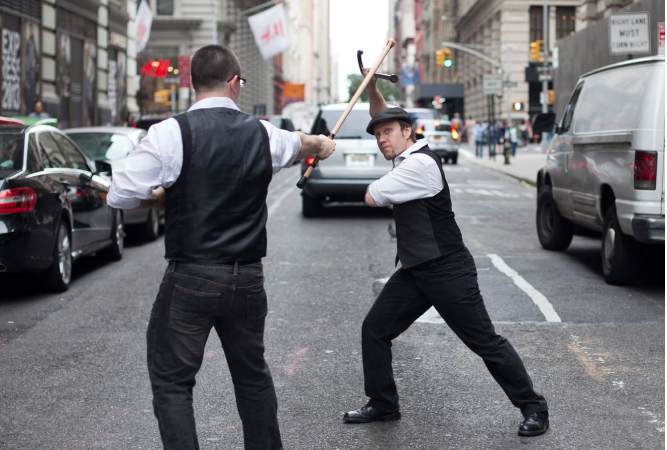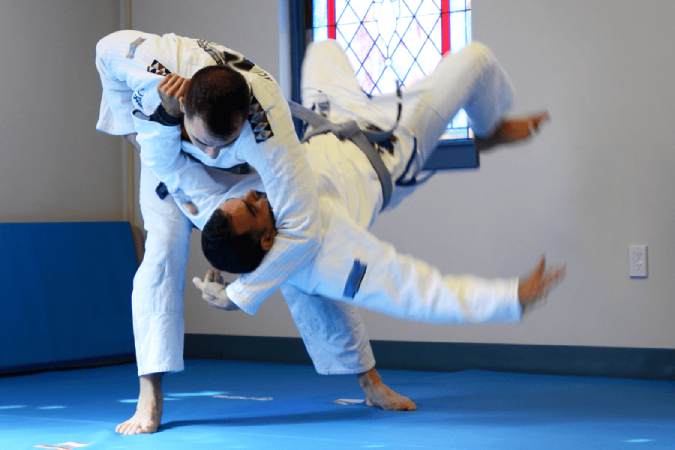Bartitsu is a gentleman’s martial art form that uses elements from boxing and Jiu-Jitsu. The Bartitsu cane may look like a simple walking stick, but it can be a very dangerous weapon when placed in the hands of a person familiar with Bartitsu techniques.
Edward William Barton-Wright founded the martial art form in the Victorian era, and Bartitsu is the first martial art form in the Western World.
Originally, Bartitsu was created in the early 1900s, but it became quite popular by Sir Arthur Conan Doyle, the author of the Sherlock Holmes books. Many people are still unfamiliar with Sherlock Holmes’ unique eclectic martial art form; until today.
We at MMAWhisperer, sometimes like to travel back in time and explain the roots of today’s martial arts. Our article will discuss the art of Bartitsu training and how to learn Bartitsu techniques.
Table of Contents
History Of Bartitsu

Before Dana White and all the “big dogs” in the UFC like Conor McGregor, Israel Adesanya, and Ronda Rousey, there was Edward William Barton-Wright and Bartitsu. Arguably the first self-defense method that combined many other martial art forms, Bartitsu paved the way for the fighting styles that many of us love today.
Barton-Wright had achievements that cannot be overstated; he practiced cane fighting, boxing, Jiu-Jitsu, and French kickboxing, also known as savate. Remember, this all happened in 1898.
Off to a rocky start, Barton-Wright’s discipline and the self-defense method would never get the same recognition worldwide if not for Arthur Conan. He was a writer that became fascinated with the fighting style so much that he wrote about the main character who uses Bartitsu.
The character’s name was Sherlock Holmes. Whether you picture it as a bald guy with mustaches or Benedict Cumberbatch, Bartitsu helped Sherlock throughout every mysterious adventure.
Barton-Wright went on a journey to Japan, where he practiced judo and Jiu-Jitsu. Combining these arts, he created the self-defense method, which utilizes a walking stick and is usually performed in a suit hence the name.
Barton-Wright had so many achievements and was ahead of his time. Today, he is known as the precursor of modern mixed martial arts.
The Basics Of Bartitsu Training

Bartitsu is known as The Gentleman’s Martial Art Form because it teaches you techniques you can use on the street while wearing a suit. The fighting style combines judo, boxing, kickboxing, and, most importantly, Jiu-Jitsu.
When it comes to Bartitsu training, people train in active clubs. The clubs are specifically designed for people who like to learn Bartitsu. The self-defense method is based on hands only, using a Bartitsu cane or a walking stick and controlling the objects in the environment while using them to your advantage.
The Bartitsu training is performed in suits, and practitioners polish their techniques with every swing and every punch. There are three stages to Bartitsu training.
- Warning
- Using a walking stick
- Distraction
Let’s briefly explain each one.
Stage 1 – Warning
To learn Bartitsu, like in Jiu-Jitsu today, people implement a lot of discipline. For that reason, the battle does not start immediately, and the person familiar with Bartitsu techniques first gives a warning by pushing the other person in the abdomen.
After two strikes and warnings, he realizes he is not avoiding this altercation and starts using fists to attack the opponent.
Stage 2 – Using a walking stick
In training, each person has a Bartitsu cane to use for offense or defense. However, people also learn how to defend themselves using everything around them. Another great alternative to the walking stick would be an umbrella. The end of the umbrella is a hook that will allow you to lure the opponent and tackle them. There are many Bartitsu techniques which we will explain a little further in our article.
Stage 3 – Distraction
Despite being a gentleman’s sport, Bartitsu allows you to use sneaky moves to surprise the opponent and catch them off guard. After two warnings, if the fellow is quite big and will not stop coming, Bartitsu practitioners will use sand from the street or a handkerchief from their pocket to distract the opponent. After the guard is down, then the fighting combinations begin.
What Is The Bartitsu Club?

Edward William Barton-Wright was an English railroad engineer who spent three years in Japan practicing Jiu-Jitsu. When he returned home, he invented Bartitsu, a martial art form that combines judo, Jiu-Jitsu, and boxing.
At first, people mocked his invention and techniques, but later, he wrote an article entitled “A New Art of Self Defense”, which caught the eye of the London population.
In 1901, Barton followed his ambition and opened a school called the Bartitsu Club. The school was his dream, and he put a lot of effort into it. He even brought some of the best martial artists to teach at the school.
The Bartitsu Club had legends like K. Tani, S. Yamamoto, and Armand Cherpillod. You can picture the club as a glittering hall with electric lights where champions prowl like tigers.
Bartitsu became quite popular across England after Sherlock Holmes, and everyone wanted to try it. Unfortunately, the sport declined in popularity, and the school closed a couple of years after.
Today, many modern Bartitsu Clubs are filled with people who are impressed with Robert Downey Jr.’s Bartitsu skills and like to mimic his movements.
What Martial Art Forms Are Part Of Bartitsu?
To learn Bartitsu, you first must be aware of the martial art forms combined in the sport. During his time in Japan, Barton-Wright trained in Jiu-Jitsu, judo, and boxing. However, some other Bartitsu techniques are unique and need more explanation.
Fighting with a stick
Using a stick as a primary weapon is not something that Barton-Wright invented. Stick fighting is a French martial art form called “la canne”. For that reason, Barton-Wright brought Pierre Vigny, a professional in stick fighting to help him with the technique.
Before any other martial art form, Barton-Wright wanted to polish everyone’s stick fighting skills because every top-class Englishman always carried one. Vigny upgraded the traditional stick fighting techniques and turned objects like umbrellas into weapons.
Stick fighting has a simple yet efficient way to win an altercation in the street. You can attack the face, neck, wrists, knees, head, and shins.
Improvisation
Technically, improvisation is not a martial art form but something you are gifted with. However, when it comes to Bartitsu, it is very important. Barton-Wright realized that by combining many fighting styles, you can always be prepared for the next move and use your environment to your advantage.
In Bartitsu, you can use your coat, hat, or handkerchief to surprise the opponent. Barton-Wright implemented many creative and effective self-defense methods that utilize the object in the surroundings as weapons. Edward William Barton-Wright discussed a lot about the surprise element in the article for Pearson’s Magazine.
Jiu-Jitsu
Bartitsu has Jiu-Jitsu implemented in the name. Barton-Wright implemented three principles from Jiu-Jitsu into his martial art form, and they are:
- To disrupt the equilibrium of the opponent
- Catch the opponent off guard and attack before they regain their strength and balance
- Focus and attack on the weak spots like joints, neck, shoulders, jaw, knees, elbows, and wrists

French kickboxing
La savate (pronounced “savat”) is a French kickboxing system that fighting sailors mainly used. This fighting style was popular in the 19th century and turned fists into deadly weapons. La savate consists of grappling, multiple kicks, and open-hand slaps.
Boxing
Boxing was quite different in the 19th century and has drastically changed. What caught the eye of Barton-Wright was the style of boxing that was popular among the fisticuffers of that period.
Compared to today’s boxing world, which is expensive and divided into categories, in the early years of the 20th century, boxers maintained a firm and upright stance. What is now known as “a jab” in that period was called “a hand extension”. Fighters used their forearms to cover their chest area and protect their head.
Bartitsu Techniques
Bartitsu moves for attack
Because the gentleman’s fighting style combines several martial arts, Bartitsu practitioners must know how to attack or prevent one.
Bartitsu cane techniques
The walking cane is great for self-defense but can also be deadly when placed in the right hands. The most effective attacking technique with the cane is the jab. The jab can be executed with the point or the handle of the walking stick.
Using the stick, you can stab the opponents, quickly retract their hands, and cause a lot of pain. Plus, a jab is quite difficult to avoid.
Similar to the jab is the thrust. This move also uses a stabbing motion but from a longer distance. It requires a full extension of the arm while still protecting your body. The thrust can be performed with a lunge forward, like in fencing.
You can make one more attack with the stick. When the cane is used in a chopping motion, despite not having a blade at the end, it can still effectively cut and slash.

Bartitsu “savate” techniques
You can cause a lot of damage to your opponent by only using your fists. This is where the “savate” comes in handy (literally). Coup de pied bas, another French kickboxing technique, is often used in Bartitsu. This move attacks the lower part of the leg, which trips the opponent to the ground.
Bartitsu moves for defense
To defend yourself, Bartitsu allows you to use your items and clothing. You can use a cloak or an overcoat to grab the opponent’s hand. This can be helpful if the attacker has a weapon or knife. Your hat can also be used to prevent any weapons from coming through.
To use the element of surprise, you can also use a handkerchief and throw it into the eyes of the opponent.
Best Bartitsu Books
If you are interested in the art of Bartitsu, you can expand your knowledge by acquiring the following books.
- Bartitsu – The Walking Stick Method of Self-Defense
- The Bartitsu Compendium Volume 1: History and the Canonical Syllabus
- The Bartitsu Compendium Volume 2: Antagonistics
Bartitsu Guide – Final Word
There you have it, the full Bartitsu guide – walking cane self-defense. The art of Bartitsu allows you to defend yourself with a cane or using your items. The gentleman’s martial art form is great for exhilarating and elegant exercise.




